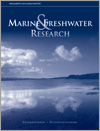Marine and Freshwater Research
Volume 73
Number 1 2022
Trends in six water quality variables at 1051 river monitoring sites across New Zealand pertaining to the 28-year period between 1990 and 2017 were attributed to a combination of land use indicators and climate variability. At durations of 10 years, land use signals were generally swamped by the effects of climate variability. At the 20-year duration, land use and changes in land use were associated with both water quality improvement and degradation.
A component of the variability in trends in 10 water quality variables at 56 river monitoring sites across New Zealand pertaining to the 31-year period between 1989 and 2019 were attributed to the El Niño–Southern Oscillation (ENSO) climate pattern quantified by the Southern Oscillation Index (SOI). The trend in the SOI explained some of the variation in site and aggregate trends between rolling windows of 5-, 10- and 15-year duration through the study period. Climate variability makes a significant contribution to water quality trends, even at timescales longer than the ENSO cycle, and our models can be used to quantify this contribution for individual sites and for aggregate trends.
Palaeoecological research was conducted on two sediment cores from wetlands within the Fitzroy Basin, central Queensland. Both records indicated millennial climate variability (El Niño–Southern Oscillation, Little Ice Age) and increased land-use intensification. Results are compared with the Regional Ecosystem classification scheme, which indicates greater similarity in environmental conditions from present-day and ~1000 years ago, while wetter conditions prevailed pre-European settlement.
Reefs of the flat oyster (Ostrea angasi) once occurred in many of the bays and estuaries on the southern coastline, but current stocks are considerably reduced from their historical levels. Overfishing appears to have caused the initial decline, with the destruction of oyster beds and hard substrate by dredging exacerbating the problem. The lack of natural recovery indicates that restoration efforts are required if the ecosystem services provided by oyster reefs are to be returned to Oyster Harbour.
Official catch data under-represent the importance of freshwater fisheries, limiting the food security and livelihood value of these crucial Kenyan waterbodies. Reconstructed data show freshwater catches were 32% higher than reported over the past six decades. Subsistence fisheries represent the majority of unreported catches and should receive more attention from decision makers to promote sustainable food and livelihood security.
We evaluated whether we could more rapidly estimate the age of longnose skates using a new approach, namely, shining near infrared light through their vertebrae. This approach produced age estimates comparable to those from traditional methods for most of the included age range, and in a quarter of the time. Findings show promise for increasing the amount of age data available for age-structured population assessments to monitor the status of this species.
Although the optimal physiological condition is high salinity, the marine-originated goby (Gymnogobius petschiliensis) also uses freshwater habitats. Field surveys showed that, although most adults of the species usually inhabited freshwater habitats in central Japan, spawning occurred mainly in estuarine areas. This suggests that they needed to migrate downstream for successful reproduction, which was inhibited in freshwater because of physiological constraints.
Recently, cyanobacteria that have not been observed in the past have been occasionally found in South Korea. In this case, the question arises as to whether these species are newly introduced from outside or whether native species have became conspicuous due to environmental changes, such as global warming. In this study, we use morphology and genetics to provide a plausible answer to this question.
Freshwater crayfish are among the most endangered animal groups in the world. We examined bias associated with baited traps for members of this diverse group in Australia. We confirmed that traps predominantly captured large males, whereas their abundance was underestimated two- to three-fold when compared with that from baited video surveys. Animals avoided traps with a captive crayfish. Video techniques can better inform conservation efforts.
The highly resident Mustelus mustelus from the Langebaan Marine Protected Area (MPA) have been protected from fishing activities for 30 years. Residency of M. mustelus inside the MPA is largely as a result of their movement to avoid warm and cold water outside their thermal preference. The influence of environmental conditions on how an MPA is used by this species emphasises the importance of considering environmental preferences in spatial conservation initiatives.
We provide a detailed view of roosterfish (Nematistius pectoralis) diel vertical behaviour along a continuous rocky habitat derived from pop-up satellite archival tags. Contrary to shallow-water habitats, roosterfish were diurnally active and exhibited diel vertical behaviours. Alterations of vertical behaviour across habitats illustrate how habitat influences behaviour and the importance of studying organisms throughout their range.
This study explored electronically tagged fish as autonomous monitors of aquatic habitats. Using a migratory freshwater fish in Lake Erie, we showed that the fish could provide information on temperature patterns from times and places that researchers were not able to measure. This approach could become an integral part of ongoing research to understand habitat changes in aquatic environments.
We respond to criticisms published in Marine and Freshwater Research on a paper of ours published in another journal on the relative importance of direct and indirect effects of salinity on stream invertebrates. We also present new data to support our conclusions and discuss how the question we sought to address can be advanced.





